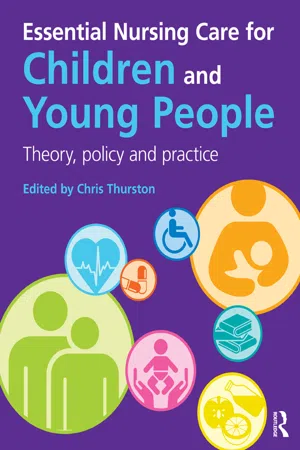
Essential Nursing Care for Children and Young People
Theory, Policy and Practice
- 472 pages
- English
- ePUB (mobile friendly)
- Available on iOS & Android
Essential Nursing Care for Children and Young People
Theory, Policy and Practice
About This Book
Essential Nursing Care for Children and Young People is the definitive guide for all nursing and healthcare students and professionals caring for children and young people. Designed to meet the 2010 NMC competency standards for pre-registration nurses, the textbook supports you through the process of caring for children and young people with varied needs and conditions across all healthcare settings.
A practical, patient-centred approach is taken throughout, with the 'voices' of children, their families and their carers used to tie theoretical knowledge to the real experience of providing care. The inclusion of the latest research and health and social care policies ensures that you are fully in line with the latest clinical practice, whilst the book's activities and exercises allow you to regularly check your understanding and develop confidence during your journey from student to nursing professional.
Main features:
Course-Focused Approach – pedagogy and content designed specifically for all three years of the child nursing degree programme.
Contemporary Content – research note features and policy integrated throughout to give you instant access to the latest evidence-based practice.
Illustrated Throughout – this highly accessible text regularly uses pictures and diagrams to highlight key issues.
Voices – include authentic experiences of children, young people, parents, carers and professionals to help develop a patient-focused attitude to care.
Pertinent A&P – includes coverage of all relevant anatomy and physiology for child and young person nursing courses.
Practice Guidelines – provide practical guidance on everyday procedures for your quick reference.
Activities and Answers – allow you to check your knowledge and build confidence.
Specialist Authors – each chapter is written by leading experts in each area.
Essential Nursing Care for Children and Young People is the ideal main textbook for all undergraduate child and young person nursing students, as well as professionals wanting to ensure they are using the latest practice. This text is also relevant to any student or professional involved in the health and social care of children and young adults.
Frequently asked questions
Information







Table of contents
- Cover
- Half Title
- Title Page
- Copyright Page
- Brief Contents
- Table of Contents
- Preface
- Chapter Summaries
- Authors
- Acknowledgements
- Chapter 1. Foundations of Children and Young People’s Nursing
- Chapter 2. Using Developmental Theories to Enhance Holistic Care
- Chapter 3. Health Promotion Needs of Children and Young People
- Chapter 4. Cultural Aspects for Children and Young People
- Chapter 5. Safeguarding Children and Young People
- Chapter 6. Caring for Children in a Variety of Settings
- Chapter 7. Caring for Children and Young People in the Medical Setting
- Chapter 8. Caring for Children and Young People in the Surgical Setting
- Chapter 9. Neonatal Nursing Care
- Chapter 10. Emergency Care of Children and Young People
- Chapter 11. The Challenges of Sexual Exploration for Young People
- Chapter 12. Mental Health and the Challenges of Mental Ill Health
- Chapter 13. The Challenges for Children and Young People with Learning Disability from Black Asian Minority Ethnic (BAME) Background
- Chapter 14. Children and Young People with Life-Limiting Conditions
- Chapter 15. Preparation for Professional Practice
- Chapter 16. Transferring to Adult Services for Young People with Long-Term Conditions
- Chapter 17. Research with Children and Young People
- Glossary
- Index